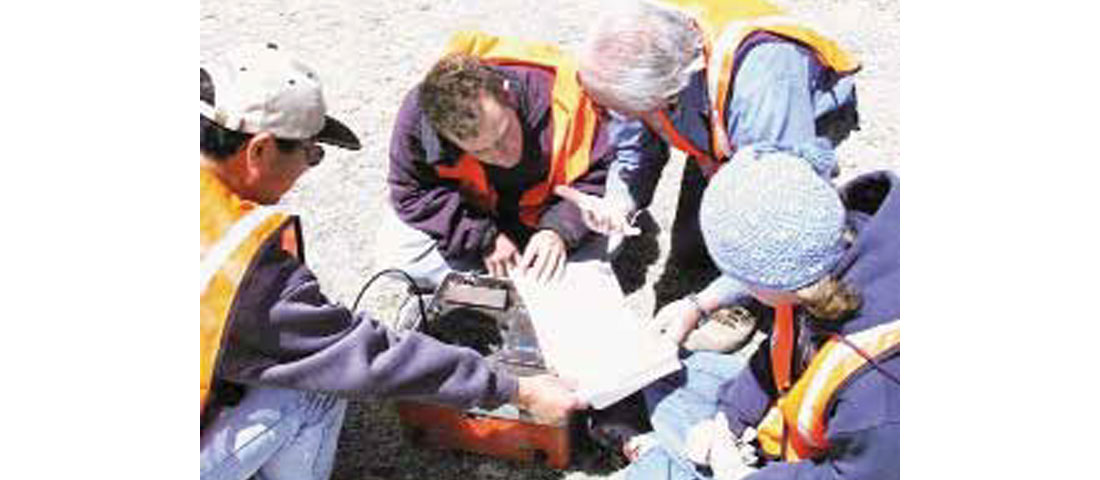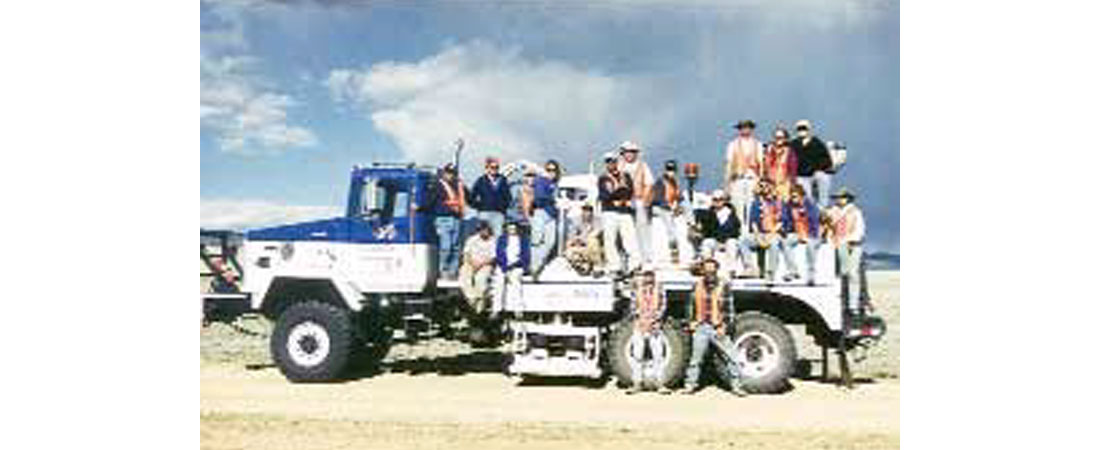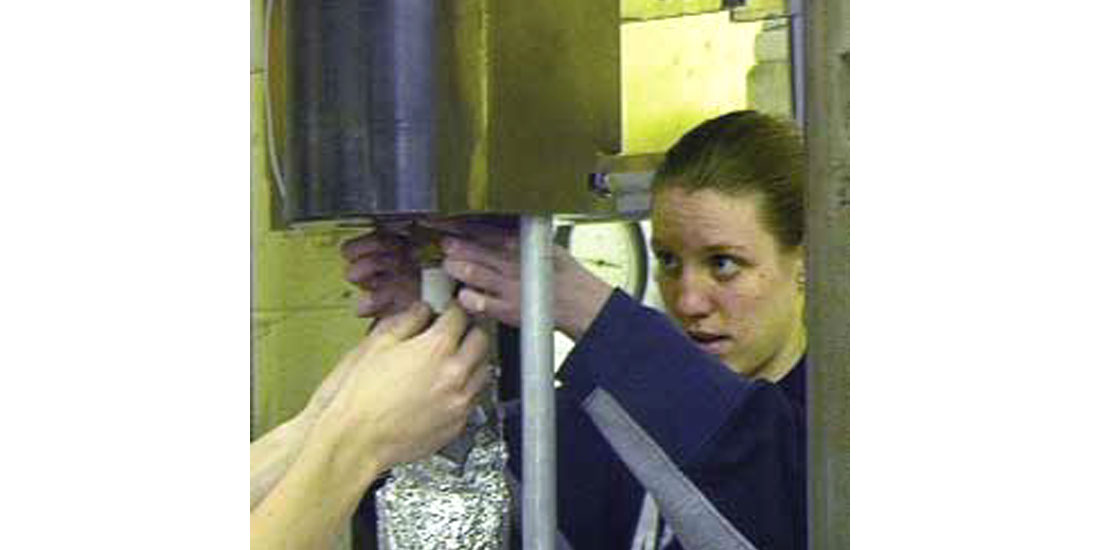Background
When some people first hear of the Colorado School of Mines, they are not sure whether it is “Mines” or “Minds”. For many, the reference to “Mines” conjures up a limited image of what this institution must be about. It may be a surprise, then, to learn that “Mines”, aboard the ill-fated space shuttle Columbia, had just launched experiments on applications of combustion in space or that “Mines” was selected to lead a coalition of Colorado universities and medical organizations in biomedical research. It is written in the State of Colorado statutes, that “The Colorado School of Mines shall be a specialized baccalaureate and graduate research institution....” with “....a unique mission in energy, mineral, and materials science and engineering and associated engineering and science fields....”. Geophysics is one of the disciplines at the heart of this mission.
The program of applied geophysics at Colorado School of Mines (CSM or “Mines”) began when Carl Heiland arrived on campus in 1926 and taught the first course on this subject. It is noteworthy that this is the same timeframe in which seismic refraction methods were being developed to explore for oil and gas in the vicinity of salt domes in the Gulf of Mexico. It is also about this same time that the Schlumberger brothers developed electrical logging methods in France.
Today, the Department of Geophysics at Mines is a separate academic department with a steady enrollment of 100 students divided 50-50 between the undergraduate and graduate programs. The Department grants B.Sc., M.Sc. and Ph.D. degrees. To date, the Colorado School of Mines has graduated 1800 students with degrees in geophysics who now serve in industry, government laboratories, universities, and energy ministries around the globe. The baccalaureate program is in geophysical engineering, rather than geophysics, and is one of only two accredited programs of geophysical engineering in the United States. At M.S. and Ph.D. levels the department offers degrees in both geophysics and geophysical engineering.
The department has over twenty faculty members. A dozen of these are regular academic faculty while the rest are research faculty and distinguished senior scientists. Most of the faculty members established their reputations first in industry (e.g., Western Geophysical, Amoco, Mobil, Shell) or in governmental agencies (e.g., the U.S. Geological Survey) prior to coming to Mines.

A hallmark of the department is its summer field camp that has been taught continuously for fifty years. Undergraduates are required to attend field camp between their junior and senior years. The camp includes a week of shallow (near-surface) geophysics (Figure 1) and a week of deep seismic reflection profiling. The latter is facilitated by the generous provision of a couple of vibroseis systems and crews by Veritas and the donation of a SN388 recording system and supporting expertise by Sercel (Figure 2).

This article is not a comprehensive discussion of all research activities in the department. Rather, it first highlights research relevant to the oil industry and concludes with description of a few non-petroleum research projects.
Highlight of Petroeum-Related Research
Five main research centers operate within the Department of Geophysics, which all perform research primarily supported by the oil and gas industry:
- Center for Wave Phenomena
- Reservoir Characterization Project
- Gravity and Magnetics Research Consortium
- Center for Petrophysics
- Fluids in Rocks Project (“The Center for Rock Abuse”)
Perhaps the largest and best known geophysical research programs at Mines are the Center for Wave Phenomena and the Reservoir Characterization Project. Each is sponsored by 20 to 30 domestic and foreign oil companies and geophysical service companies, has been operating for 20 years and provides support for 10 to 15 graduate students. The two centers have complementary programs. CWP is primarily focusing on theoretical and computational aspects of the complex reservoir environments in which RCP is doing 4D (time-lapse) field studies.
Center for Wave Phenomena
(http://www.cwp.mines.edu/)
The Center for Wave Phenomena (CWP) is directed by Ken Larner. CWP pursues an interdisciplinary research program in inverse problems and problems of seismic data processing and interpretation. The research of CWP has applications to seismic exploration, mapping the seabed, ocean sound-speed profiling, nondestructive testing and evaluation, and other areas. Faculty and students working in CWP make extensive use of analytical techniques, especially asymptotic methods and computational techniques. The end result of their research is generally computer implementation, based on the philosophy that the ultimate test of an inverse method is its application to field or experimental data.
Reservoir Characterization Project
(http://www.mines.edu/academic/geophysics/rcp/)
The Reservoir Characterization Project (RCP), directed by Professor Tom Davis, specializes in acquiring, processing and interpreting time-lapse, multi-component (4-D, 3-C) seismic data. RCP works with its industry partners to develop a multidisciplinary approach to dynamic reservoir characterization in order to enhance oil recovery. The project, which sponsors not only geophysics graduate students but also graduate students in geology and petroleum engineering, reflects the philosophy of earth science and engineering education at CSM, where students from these disciplines work together on teams in integrated interpretation classes. Over 60 students from the geophysics, geology and petroleum engineering departments have completed theses based on the research of RCP.
The companies that sponsor RCP get to choose where the project will conduct its field studies. In its 20 years to date, all of RCP’s field experiments have been conducted on land. Since 2000, the project has focused on time-lapse characterization of EnCana’s Weyburn Field in Saskatchewan with the goal of providing a detailed underground picture of a section of the oil-rich reservoir before and after CO2 flooding. In three successive autumns, RCP has acquired first a baseline and then two monitor 3-D surveys at Weyburn. For the next phase of its program, RCP sponsors have voted to take the project offshore, probably to the UK sector of the North Sea.
The Anisotropy Team
The “A-Team” (stands for the Anisotropy Team) is a group of professors and students from both the Center for Wave Phenomena (CWP) and the Reservoir Characterization Project (RCP) doing research in seismic anisotropy. Guided by professors Ilya Tsvankin and Ken Larner, the A-Team works on practical methods of processing and inversion of seismic data for realistic anisotropic, heterogeneous subsurface models.
The work within the A-Team over the past decade has led to a number of breakthroughs that show not only how to correctly process seismic data in the presence of anisotropy but also how to derive the parameters of the anisotropic subsurface which carry crucial information about lithology and fracture networks.
The main focus of current A-Team research is anisotropic parameter estimation and imaging using multi-component multi-azimuth 3-D reflection data, with emphasis on analysis of mode-converted PS waves. The importance of the A-Team’s results is widely recognized by the exploration community and government agencies.
The team actively participates in the research program of the U.S. Department of Energy, currently collaborating with colleagues from Stanford and the Lawrence Livermore National Laboratory on a large DOE project aimed at exploration and development of naturally fractured reservoirs.
One of the main reasons for the group’s success is active interaction both among A-Team members and with many research groups around the globe, in particular with geophysicists in companies sponsoring CWP and RCP. Although the main attraction of the weekly A-Team seminars may be the famous anisotropic cookies, the seminars are also known for their sometimes heated discussions and informal atmosphere that foster creativity and help students to embark on new projects.
Gravity and Magnetics Research Consortium
(http://www.geophysics.mines.edu/gmrc/)
The Gravity and Magnetics Research Consortium (GMRC), directed by Dr. Yaoguo Li, is a newly formed facility for carrying out industry-sponsored research in gravity and magnetic methods. GMRC is working on a variety of problems ranging from theory, modeling, inversion and interpretation to field applications. The goal is to develop new techniques that can solve practical exploration and production problems by utilizing the latest developments in geophysical inverse theory, applied mathematics and modern instrumentation. The current research at GMRC is focused on the processing, inversion and interpretation of gravity gradiometer data. Gravity gradiometer data measure the spatial gradients of the three components of the gravity field and they have fewer platform-induced measurement errors and possess a higher resolving power than conventional gravity data.
GMRC has been using wavelet transforms to tackle a variety of problems ranging from data processing to 3-D inversion of gravity gradiometer data. In an effort to introduce this new method to the larger community of potential-field researchers and practising geophysicists, the GMRC, in collaboration with its sponsoring companies, organized and presented a web-based workshop on the application of wavelet transforms to potential-field problems. The workshop featured seven invited speakers from the United States, France and Australia, three of whom were from CSM. The workshop was presented live in Houston and broadcast simultaneously through the Internet to eleven remote sites worldwide. The web-based delivery of the workshop reached a much wider audience than would have been possible by conventional approaches. Generous contributions from Dr. Tom LaFehr, the Rutt Bridges Family Foundation, the Society of Exploration Geophysicists and Shell enabled students and members of the academic community to attend the workshop free of charge at various locations. This activity has prompted a great deal of interest in the use of wavelet transforms in gravity and magnetics.
Center for Petrophysics
(http://www.geophysics.mines.edu/petrophysics/)
The Center for Petrophysics (CENPET) is currently supported by five companies and provides M.Sc. projects for seven students. This center is directed by Max Peeters, the Baker Hughes Professor of Petrophysics and Borehole Geophysics. Thesis subjects include monitoring invasion of mud filtrate in horizontal boreholes with ground penetrating radar (GPR), simultaneous inversion of shallow reading wireline logs to improve porosity and permeability estimates, measuring fluid and lithology effects on acoustic wave propagation in a shock tube, and comparing the response of acoustic and resistivity imaging tools to structural and stratigraphic rock features.
Center for Rock Abuse
(http://crusher.mines.edu/)
For those acquainted with Professor Mike Batzle, it comes as no surprise that the name he has chosen for his research center is The Center for Rock Abuse. Mike can usually be found down in the bowels of the Green Center where he has set up a laboratory to pursue fundamental research concerning the detection of fluids, especially hydrocarbons, in rocks. Mike and his students are conducting experiments on rock samples (Figure 3) and integrating their findings with seismic data acquired over sponsors’ reservoirs. This research is a cooperative effort with the Houston Advanced Research Center and involves faculty participants from other CSM departments, including Geology and Geological Engineering, Petroleum Engineering, and Mathematics and Computer Sciences. At the most recent annual meeting of the SEG, Mike and his colleague, Zee Wang, were awarded the Virgil Kaufman Gold Medal for “original and continual development of the petrophysical transforms that estimate the elastic properties of pore-fluid saturants.....”.

Non-Petroleum Research
In addition to the five research centers just described, the department conducts non-petroleum research such as the work of Professor John Scales in his Physical Acoustics Laboratory (PAL), the various environmental, geotechnical and planetary research projects of Professor Gary Olhoeft, the research on detection and identification of unexploded ordnance (UXO) by Dr. Yaoguo Li and avalanche forecasting by Professor Terry Young. Included below is a brief summary of some of the work being directed by professors Scales and Olhoeft.
Physical Acoustics Lab
(http://acoustics.mines.edu/)
The Physical Acoustics Lab (PAL) is an outgrowth of the work that originated under the auspices of CWP. Over the past five years, Professor John Scales and his graduate students have built a laboratory that is unique in its ability to optically analyze complex elastic wave propagation and resonance phenomena in earth materials. This has put Scales’ group at the nexus of a variety of international collaborations pursuing both fundamental physics and geophysics research as well as important practical problems ranging from oil exploration and near-surface characterization to non-contacting landmine detection.
Scales and his group in PAL study the properties of waves in rocks and other complicated materials. They specialize in the use of non-contacting ultrasonic methods that exploit lasers to both excite and detect waves. Their interest in the properties of waves at such high frequencies (compared to seismic waves) is two-fold. On the one hand it is important to know the frequency dependence of material properties over many orders of magnitude to check theoretical work on “up-scaling” of the microscopic properties of rocks. The use of resonance and wave propagation enable them to study frequencies from a few KHz up to hundreds of MHz. On the other hand, and this may seem surprising in the year 2003, there are many aspects of wave propagation in heterogeneous media that are not well-understood. This is especially true when it comes to multiple scattering, that is, when waves bounce around repeatedly. If there is strong multiple scattering it turns out that seismic waves propagate diffusively, like heat, rather than ballistically, like true waves. In the PAL, researchers analyze the physics of wave propagation with precision and clarity that would be impossible to obtain in the field. In order to exploit multiply scattered waves in field data it is crucial to understand the theory. Applications of these new ideas to seismic and radar field data are in the planning stage, but laboratory measurements have proven to be invaluable in enhancing understanding.
Students in the PAL interact with other groups in the department, especially Professor Batzle’s Rock Abuse Laboratory and the theoretical group of Professor Roel Snieder. For example, Snieder and his students have developed a new technique that uses multiply scattered seismic waves to detect small changes in material properties. Key measurements illustrating this theory were carried out in the PAL. Further, laser-based methods may open up new areas of rock physics measurements. Other groups on campus are also interested in utilizing non-contacting ultrasonic methods in a variety of applications, especially in the characterization of material properties where it is impossible or impractical to use contacting sensors. This could be at the very small scale or with samples too fragile to attach sensors to, or in hostile environments such as quarry blasts, mines or combustion chambers. It may even be possible to use lasers to remotely detect land mines.
Those who have the good fortune of working in the PAL enjoy using cutting edge technology to study the fundamental aspects of wave propagation while at the same time doing research that may have a long-term impact on geophysical exploration, near-surface characterization, materials science and other problems of economic and social important. Major funding for the PAL has been provided by the U.S. Army Research Office and the National Science Foundation.
Environmental Geophysics and Water on Mars
A Master’s student of Professor Gary Olhoeft just completed her thesis studying the use of nonlinear complex resistivity (NLCR) to characterize and map DNAPLs (Dense Non-Aqueous Phase Liquids). One of the most common industrial contaminants, perchloroethylene or PCE, was found to react with smectite clays from the U.S. Department of Energy’s Savannah River Technology center in South Carolina. Using laboratory and field instrumentation and software designed and built by Professor Olhoeft, and working jointly with Blackhawk Geoservices Inc. with funding from DOE, the student showed that PCE could be detected with NLCR at the fractional part per million level in the laboratory. The team then proceeded to conduct hole-to-hole NLCR measurements in the field at Savannah River, demonstrating that PCE could also be detected and mapped in 3-D in the vadose zone at the ppm level. Innovative unsaturated zone borehole electrodes were developed for in situ emplacement for long term monitoring. Further work is required to fully exploit the nonlinear information inherent in the data and descriptive of the clay-organic chemical processes.
In a very different project, Professor Olhoeft has just been awarded a three-year NASA contract to study the impact of magnetic minerals (the “red” colour) on the use of electromagnetic instruments to search for water on Mars. As the invited keynote speaker at a recent conference, Olhoeft presented a paper entitled Subsurface Geophysical Detection Methods to Uniquely Locate Water on Mars
Student Kudos
It is fitting to conclude this article by recognizing that, in an institution like Colorado School of Mines, students add another entire dimension to geophysics research that makes it all the more interesting and rewarding. At Mines, 20% of geophysics undergraduates and 58% of geophysics graduate students come from outside the United States. International students have recently come to the geophysics department from such countries as Canada, Mexico, Brazil, Chile, Columbia Venezuela, Netherlands, France, Germany, Switzerland, Portugal, Spain, Bulgaria, Denmark, Norway, Azerbaijan, Indonesia, Malaysia, India, China and Saudi Arabia.
Further information about the Department of Geophysics at Colorado School of Mines can be found on the Internet at www.geophysics.mines.edu.











Join the Conversation
Interested in starting, or contributing to a conversation about an article or issue of the RECORDER? Join our CSEG LinkedIn Group.
Share This Article